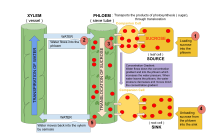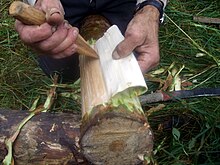Phloem
Phloem (
Structure
Phloem tissue consists of conducting
Conducting cells (sieve elements)

Sieve elements are the type of cell that are responsible for transporting sugars throughout the plant.
Parenchyma cells
Other parenchyma cells within the phloem are generally undifferentiated and used for food storage.[10]
Companion cells
The metabolic functioning of sieve-tube members depends on a close association with the companion cells, a specialized form of
There are three types of companion cells.
- Ordinary companion cells, which have smooth walls and few or no plasmodesmatal connections to cells other than the sieve tube.
- Transfer cells, which have much-folded walls that are adjacent to non-sieve cells, allowing for larger areas of transfer. They are specialized in scavenging solutes from those in the cell walls that are actively pumped requiring energy.
- Intermediary cells, which possess many vacuoles and plasmodesmata and synthesize raffinose family oligosaccharides.[11][12]
Albuminous cells
Albuminous cells have a similar role to companion cells, but are associated with sieve cells only and are hence found only in seedless vascular plants and gymnosperms.[10]
Supportive cells
Although its primary function is transport of sugars, phloem may also contain cells that have a mechanical support function. These are sclerenchyma cells which generally fall into two categories:
Fibres
Bast fibres are the long, narrow supportive cells that provide tension strength without limiting flexibility. They are also found in xylem, and are the main component of many textiles such as paper, linen, and cotton.[10]
Sclereids
Sclereids are irregularly shaped cells that add compression strength[10] but may reduce flexibility to some extent. They also serve as anti-herbivory structures, as their irregular shape and hardness will increase wear on teeth as the herbivores chews. For example, they are responsible for the gritty texture in pears, and in winter pears.[13]
Function

Unlike
During the plant's growth period, usually during the spring, storage organs such as the roots are sugar sources, and the plant's many growing areas are sugar sinks. The movement in phloem is multidirectional, whereas, in xylem cells, it is unidirectional (upward).[citation needed][15]
After the growth period, when the meristems are dormant, the leaves are sources, and storage organs are sinks. Developing seed-bearing organs (such as fruit) are always sinks. Because of this multi-directional flow, coupled with the fact that sap cannot move with ease between adjacent sieve-tubes, it is not unusual for sap in adjacent sieve-tubes to be flowing in opposite directions.[16]
While movement of water and minerals through the xylem is driven by negative pressures (tension) most of the time, movement through the phloem is driven by positive
Phloem sap is also thought to play a role in sending informational signals throughout vascular plants. "Loading and unloading patterns are largely determined by the
Organic
Phloem is also used as a popular site for oviposition and breeding of insects belonging to the order Diptera, including the fruit fly Drosophila montana.[18]
Girdling
Because phloem tubes are located outside the
Origin
When the plant is an embryo, vascular tissue emerges from procambium tissue, which is at the center of the embryo. Protophloem itself appears in the mid-vein extending into the cotyledonary node, which constitutes the first appearance of a leaf in angiosperms, where it forms continuous strands. The hormone auxin, transported by the protein PIN1 is responsible for the growth of those protophloem strands, signaling the final identity of those tissues. SHORTROOT(SHR), and microRNA165/166 also participate in that process, while Callose Synthase 3(CALS3), inhibits the locations where SHORTROOT(SHR), and microRNA165 can go. Additionally, the expression of NAC45/86 genes during phloem differentiation functions to enucleate specific cells in the plants to produce the sieve elements.[19]
In the embryo, root phloem develops independently in the upper hypocotyl, which lies between the embryonic root, and the cotyledon.[20]
In an adult, the phloem originates, and grows outwards from,
In some eudicot families (Apocynaceae, Convolvulaceae, Cucurbitaceae, Solanaceae, Myrtaceae, Asteraceae, Thymelaeaceae), phloem also develops on the inner side of the vascular cambium; in this case, a distinction between external and internal or intraxylary phloem is made. Internal phloem is mostly primary, and begins differentiation later than the external phloem and protoxylem, though it is not without exceptions. In some other families (Amaranthaceae, Nyctaginaceae, Salvadoraceae), the cambium also periodically forms inward strands or layers of phloem, embedded in the xylem: Such phloem strands are called included or interxylary phloem.[22]
Nutritional use

Phloem of
Phloem from
See also
- Apical dominance
- Phloem sap
References
- ^
Lalonde S. Wipf D., Frommer W. B. (2004). "Transport mechanisms for organic forms of carbon and nitrogen between source and sink". PMID 15377224.
- ISBN 978-0-00-745000-8) p.124
- ^ Harper, Douglas. "phloem". Online Etymology Dictionary.
- Perseus Project.
- ^ Nägeli, Carl (1858). "Das Wachstum des Stammes und der Wurzel bei den Gefäßpflanzen und die Anordnung der Gefäßstränge im Stengel" [The growth of the stem and of the root among vascular plants and the arrangement of the vascular strands in the stalk]. Beiträge zur Wissenschaftlichen Botanik (Contributions to Scientific Botany) (in German). 1: 1–156. From p. 9: "Ich will die beiden Partien Dauergewebe, welche von dem Cambium nach aussen und nach innen gebildet werden, Phloëm und Xylem nennen." (I will call the two parts of the permanent tissue, which are formed by the cambium outwardly and inwardly, "phloëm" and "xylem".)
- ISBN 978-3-642-73637-7.
- PMID 34224570.
- ISBN 978-0-471-73843-5.
- PMID 26078728.
- ^ ISBN 978-1-4292-3995-0.
- PMID 23847646.
- OCLC 1077622456.)
{{cite book}}: CS1 maint: location missing publisher (link - ISSN 0031-9317.
- PMID 18472079.
- ^ Ciffroy, P. & Tanaka, T. "Modelling the Fate of Chemicals in Plants". Modelling the Fate of Chemicals in the Environment and the Human Body 57 (2017): 167.: 174.
{{cite journal}}: CS1 maint: multiple names: authors list (link) - ^ Canny, MJ. Phloem Translocation. p. 124.
- ^ S2CID 25574512.
- .
- PMID 25852714.
- PMID 23462277.
- S2CID 258953259.
- ISBN 0-470-04737-2.
- S2CID 147665504.
- ^ Sigrithur, Anna (2016-09-29). "Using Tree Bark Flours in Cooking". Walden Labs. Retrieved 2023-02-09.


